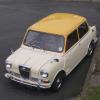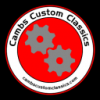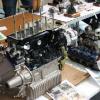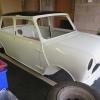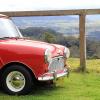I've replaced my steering column bushes today. Well, one of them.
Late last year I had my Mk2 Hornet (aka Mk1 Mini-ish) steering wheel refinished. I had useful help here in getting the little beggar off, as it didn't want to shift. Subsequently I decided that before the shiny steering wheel was torqued back up, I needed to change the column bushes as there was some play, though it had always passed the MoT. In fact, I bought the column bushes, nylon for the top, felt for the bottom, same year as I bought my car, 2011, and never used them. Well, they've been used now. Well, one of them.
The job is done. Finished. But there are (or were) issues.
1st - End float in the column, something I feared I might have caused by banging at the steering wheel to get it off, turned out to be the clamp at the lower end of the inner column not gripping the splines on the rack. The pinch bolt was tight, but the clamp not compressed enough to grip the splines. This is a familiar tale to me now on this car. It makes me wonder how many other bolts and fasteners that I've not yet discovered, aren't done up tight enough.
2nd - I couldn't use the Mini Spares supplied felt pad. It was mega thick. GSV 1127. The new nylon upper bush was a tight-ish fit, but that's because it isn't worn. Try as I might, I couldn't tempt the new oil-soaked felt pad to go into the outer tube, when wrapped around the inner column. In fact I couldn't even get the tapered ends to meet up around the inner column, the felt seemed so thick. I had real fears if I managed to force it in, I might lose my steering self-centering action! I looked at the old felt pad that had come out, and it SEEMED to be made thinner to me, not just worn. I re-soaked it in oil and put that back to see what it looked like. Put it this way, the bottom end of the inner column isn't waving about. So I only used one new bush and put GSV 1127 in the bin.
3rd - and this is what I really need a spot of advice with, though as I said, the job is done. The Haynes manual states, on refitting the column assembly, that on right hand drive cars, the axis of the pinch bolt on the clamp on the inner column must be parallel to the rack, below the column, and the indicator stalk should be fitted at 20 degrees to the horizontal.
 File3.jpg 38.94K
5 downloads
File3.jpg 38.94K
5 downloads
 File4.jpg 30.61K
3 downloads
File4.jpg 30.61K
3 downloads
So I did all this. Originally when I took the column out, the pinch bolt axis was at about 45 degrees with the wheels straight ahead, but then hey, lots of things aren't put back right on old cars. Including this one.
So I did it by the book, and clamped the inner column up with the pinch bolt horizontal. Then started puzzling about this 20 degree business of the indicator stalk - which naturally I'd not noticed when I took the thing off. To get that angle, the whole column tube, shrouds and everything have to be skewed - surely it wasn't like that before? I looked at some old pictures of my interior - and it didn't look skewed. Anyway I put it back how I thought it should be, not by the book this time, plopped my 'new' steering wheel on and loosely did up the nut, and risked a little drive to see if I'd got it on the wrong splines. I was just one spline out, so I corrected that. BUT....with the stalk where I thought it should be, i.e. horizontal when centered, if I indicated right, the little green bulb on the end was eclipsed by the steering wheel spoke and couldn't be seen when driving straight.
So back home, I torqued the steering wheel nut to the 'by the book' 45Nm (boy, that took some doing, unless my torque wrench is losing its accuracy) then skewed the outer column so the stalk was now at about 20 degrees to the horizontal when switched off.
Fine. Lovely. I can see the bulb now when turning right, even if when turning left, it seems more like I'm using a column-change than an indicator stalk!
But here is what bugs me. I had to take the shroud off again - solving rattles and so on - and I noticed this. With the inner steering column now where it is, in the straight ahead position, with the pinch bolt horizontal, the little self-cancelling stud is positioned at 3 o'clock behind the steering wheel. With the indicator stalk at 20 degrees up from the horizontal, the self cancelling stud is bang in line with the lower pawl on the indicator stalk! My indicators have never self canceled - well, they do in one direction about three times every 100 miles. And having had things to bits, I now know why. There is a missing spring on the pawls. One is there, but there should be two. So everything is a bit too floppy and my indicators do not self cancel. BUT IF THEY DID - I now think I wouldn't be able to indicate right with the steering wheel dead-ahead because the self cancelling stud would act on the pawl immediately it was operated.
And the point I'm making is, if I'd have put the steering column back with the pinch bolt at 45 degrees, the self canceling stud would have probably been roughly in the right place to fall between the two pawls on the indicator switch, with the switch set at 20 degrees to the horizontal!
So...has the Haynes book got it wrong? The same diagram I've shown is in the '69 - '89 manual, though I was using the '59 - '69 which clearly states 'Mk1 Mini'.
Now I've torqued down my shiny steering wheel so it won't come off for another 50 years (yeah, the nut was loose when I first had my horn push off over a year ago, to look for a fault with that) I don't really want to disturb anything if I find a spring one day to try to make my indicators self-cancel. But I really do NOT understand the logic of the Haynes manual instructions, now that I've followed them and finished the job. It looks to me like on right hand drive cars the pinch bolt should NOT be parallel to the rack, because the stud that knocks off the indicators is basically on the same axis, while the indicator switch is supposed to fitted on an inclined axis, which brings the knock-off pawl in line with the stud. It isn't logical, Captain.
Edited by mickthefitter, 04 May 2015 - 11:18 PM.


